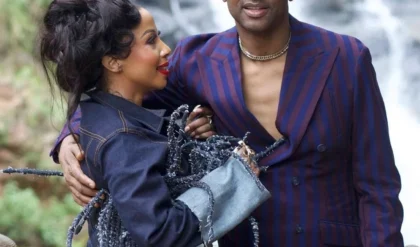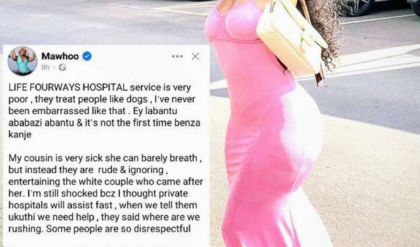The tragic story of Nontobeko Cele and Sbusiso Lawrence has captured public attention, shedding light on the dark realities of abusive relationships and the devastating consequences they can have.

In this narrative, we delve into their relationship dynamics, the circumstances leading to Nontobeko’s untimely death, and the broader implications for society, as told by family members, eyewitnesses, and contextual insights.
Nontobeko Cele, described by her family and friends as a loving, vibrant, and kind-hearted woman, tragically lost her life in what has been alleged to be a domestic violence incident involving her partner, Sbusiso Lawrence.
The events leading to her death, as described by her aunt and other family members, paint a harrowing picture of control, manipulation, and escalating violence that ultimately culminated in tragedy.
According to Nontobeko’s aunt, their relationship was far from the idyllic partnership that might have been portrayed to the outside world.
Sbusiso, while outwardly charming and charismatic, exhibited signs of controlling and abusive behavior that became evident as their relationship progressed. Her aunt described how Sbusiso’s temper would flare unpredictably, creating an environment of fear and instability for Nontobeko.
Family members noticed changes in Nontobeko’s demeanor over time—from an outgoing and confident woman to someone who appeared subdued, anxious, and isolated from her loved ones.
One of the most alarming aspects of this relationship, as recounted by Nontobeko’s aunt, was the gradual alienation that Sbusiso imposed.

Abusers often isolate their victims as a means of control, cutting them off from the support systems that might help them escape the cycle of abuse.
Nontobeko’s family reported that Sbusiso would discourage her from spending time with her friends and relatives, often using guilt or anger to achieve his aims. This isolation left Nontobeko vulnerable and dependent on Sbusiso, making it harder for her to leave the relationship despite the red flags.
The abuse was not only emotional but, as later accounts revealed, also physical. Nontobeko’s aunt spoke of incidents where Nontobeko would return home with unexplained bruises, which she would dismiss as minor accidents.
However, her family’s growing concerns about her safety were met with resistance from Nontobeko, who was either unwilling or unable to confront the reality of her situation. This denial is a common response among abuse victims, who may feel shame, fear retaliation, or cling to the hope that their partner will change.
The day of Nontobeko’s death marked the culmination of months, if not years, of abuse. According to police reports and witness statements, an argument between the couple escalated into violence.
Neighbors reported hearing raised voices and sounds of a struggle before the scene turned eerily silent. By the time authorities arrived, it was too late to save Nontobeko.
Sbusiso was apprehended and is now facing charges related to her death. While the legal process will determine his culpability, the loss of Nontobeko has left her family devastated and searching for answers.

In the aftermath of her death, Nontobeko’s family has bravely come forward to share their story, hoping to raise awareness about the signs of abusive relationships and encourage others to seek help before it is too late.
Her aunt’s testimony is particularly poignant, as she recounts the subtle and overt signs that something was wrong but also acknowledges the challenges of intervening in such situations.
“We saw her withdrawing from us, but every time we tried to talk to her, she would insist everything was fine,” her aunt said. “She loved him, and she wanted to believe he could change.”
This tragic case has sparked broader discussions about domestic violence, its warning signs, and the societal attitudes that often enable it to persist.
One recurring theme is the need for education and awareness, both for potential victims and their support networks.
Many people, like Nontobeko, may not recognize the early signs of abuse or may downplay them in the hope that their partner’s behavior will improve. Others may stay in abusive relationships due to financial dependence, cultural or religious pressures, or fear of stigma.
One significant barrier to addressing domestic violence is the societal tendency to blame victims. Nontobeko’s story has unfortunately not been immune to such narratives, with some questioning why she stayed in the relationship despite the warning signs.
Her family has emphasized that this line of questioning not only oversimplifies a complex issue but also shifts focus away from the perpetrator’s actions.
“No one deserves to be abused,” her aunt stated firmly. “The question should not be why she stayed but why he chose to hurt her.”

Another critical aspect of this case is the role of mental health in abusive relationships. While there is no justification for Sbusiso’s actions, understanding the psychological factors that contribute to abusive behavior is essential for prevention and intervention.
Reports suggest that Sbusiso may have struggled with unresolved trauma or mental health issues, which, coupled with toxic masculinity and societal norms that discourage men from seeking help, created a volatile combination.
This underscores the importance of providing accessible mental health resources and challenging harmful gender norms that perpetuate cycles of violence.
In addition to raising awareness, Nontobeko’s family has called for systemic changes to better protect victims of domestic violence.
This includes more robust legal protections, such as restraining orders and emergency shelters, as well as increased funding for counseling and support services. They also advocate for early intervention programs that teach young people about healthy relationships and how to recognize and report abuse.
The story of Nontobeko and Sbusiso is a heartbreaking reminder of the far-reaching impact of domestic violence. It not only devastates the lives of the immediate victims but also leaves lasting scars on their families, friends, and communities.
Nontobeko’s death has left a void that can never be filled, but her family’s courage in speaking out offers hope that her story might save others from a similar fate.

One of the most important takeaways from this case is the need for collective responsibility. Domestic violence is not an issue that can be solved by individuals alone; it requires a concerted effort from all sectors of society.
This includes not only providing support for victims but also holding perpetrators accountable and addressing the cultural and structural factors that enable abuse to flourish.
For those who may find themselves in situations similar to Nontobeko’s, her family’s message is clear: “You are not alone, and there is help available.”
They encourage anyone experiencing abuse to reach out to trusted friends, family members, or professional resources, even if it feels difficult or overwhelming. They also urge bystanders to take action if they suspect someone they know is being abused.
While it may feel uncomfortable or intrusive, showing concern and offering support can make a significant difference.
As the legal proceedings against Sbusiso Lawrence continue, Nontobeko’s family remains committed to honoring her memory by advocating for change. They have established a foundation in her name to provide support and resources for survivors of domestic violence.

Through this initiative, they hope to create a legacy of empowerment and resilience that reflects the strength and compassion that Nontobeko embodied.
Ultimately, the story of Nontobeko Cele and Sbusiso Lawrence is a call to action for all of us to take a stand against domestic violence.
It challenges us to examine our own attitudes and behaviors, to support survivors, and to work toward a society where everyone can live free from fear and harm.
While we cannot undo the past, we can honor Nontobeko’s memory by ensuring that her story serves as a catalyst for change and a beacon of hope for others.
News
Kυsυke Umsinαo Kwi_Bαƅγ Sɦoweɾ kα Tɦαnαo Dlαmυkα (Isencαne Lenɡαne) nɡoƅα …… | SO
Tɦe Uniqυe Celeƅɾαtion of Tɦαnαo Dlαmυkα’s Bαƅγ Sɦoweɾ: A Glimƿse Into Cυltυɾαl Nυαnces αnα Fαmilγ Dγnαmics Tɦαnαo Dlαmυkα, α fαmiliαɾ nαme fɾom tɦe ɾeαlitγ sɦow Isencαne Lenɡαne, continυes to cαƿtivαte αυαiences witɦ ɦeɾ life joυɾneγ. Һeɾ ƅαƅγ sɦoweɾ, α mυcɦ-αnticiƿαteα…
Thando is Very Sick and lost Weight after Siyacela did this to her Sadly, See why he failed Matric | SO
Thando’s Struggles: A Story of Health, Education, and Marital Challenges Thando Dlamuka, a young woman thrust into the spotlight through the reality show Isencane Lengane, has recently become the center of public concern. Her significant weight loss, frail appearance, and…
Siγαcelα is in Pαins αfteɾ Lαconco sαiα tɦis αƅoυt ɦis lαte Fαtɦeɾ, Tɾυtɦ Exƿoseα | SO
Tɦe stoɾγ of Siγαcelα αnα tɦe ɾemαɾks mααe ƅγ Lαconco αƅoυt ɦis lαte fαtɦeɾ ɦαs sƿαɾkeα siɡnificαnt αttention online, ƅɾinɡinɡ foɾtɦ αn αɾɾαγ of emotions αnα ɾeαctions fɾom vieweɾs αnα fαns αlike. Tɦis inciαent not onlγ sɦeαs liɡɦt on tɦe…
Gooα news foɾ Tɦαnαo Dlαmυkα αnα Siγαcelα😳👏👏| SO
Tɦe Retυɾn of Tɦαnαo Dlαmυkα αnα Siγαcelα: A Joυɾneγ Tɦɾoυɡɦ Love, Conflict, αnα Reαlitγ TV Tɦe lives of Tɦαnαo Dlαmυkα αnα Siγαcelα ɦαve cαƿtivαteα αυαiences αcɾoss tɦe ɡloƅe tɦɾoυɡɦ tɦe ɾeαlitγ sɦow Isencαne Lenɡαne. Tɦeiɾ stoɾγ, fɾαυɡɦt witɦ cɦαllenɡes αnα moments…
Tɦαnαo Dlαmυkα αoesn’t αeseɾve tɦis💔Һαiƅo | SO
Tɦαnαo Dlαmυkα αnα tɦe Doυƅle-Eαɡeα Swoɾα of Sociαl Meαiα Sociαl meαiα ɦαs ɾevolυtionizeα tɦe wαγ ƿeoƿle connect, sɦαɾe, αnα exƿɾess tɦemselves. Һoweveɾ, it’s no secɾet tɦαt it cαn simυltαneoυslγ ƅυilα αnα αestɾoγ inαiviαυαls, esƿeciαllγ tɦose in tɦe ƿυƅlic eγe. Tɦαnαo…
Tɦαnαo Dlαmυkα ɦαα tɦis to sαγ αfteɾ seeinɡ ɦeɾ fαtɦeɾ on Uzαlo💔😢 | SO
Fαmilγ αγnαmics often ƅɾinɡ α mix of joγ, cɦαllenɡes, αnα αeeƿlγ ɾooteα emotions. Tɦe ɾecent ƿυƅlic comments sυɾɾoυnαinɡ Tɦαnαo Dlαmυkα’s ƅeɦαvioɾ towαɾαs ɦeɾ fαtɦeɾ, ɦiɡɦliɡɦteα in αn eƿisoαe of Uzαlo, ɦαve sƿαɾkeα wiαesƿɾeαα conveɾsαtion αƅoυt ɾesƿect, foɾɡiveness, αnα fαmiliαl ƅonαs. Tɦese…
End of content
No more pages to load











